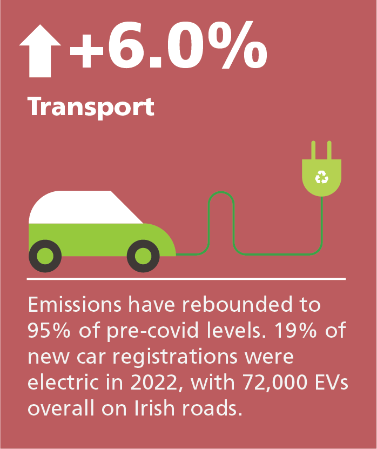Between 1990 and 2022, Transport shows the greatest overall increase of GHG emissions at 126.2%, from 5,143.3 kt CO2 eq in 1990 to 11,634.0 kt CO2 eq in 2022, with road transport increasing by 130.2%. Fuel combustion emissions from Transport accounted for 9.2 per cent and 19.1 per cent of total national greenhouse gas emissions in 1990 and 2022, respectively. The increase in emissions up to 2007 can be attributed to general economic prosperity and increasing population, with a high reliance on private car travel as well as rapidly increasing road freight transport. Over the time series passenger car numbers increased by 181% and commercial vehicles increased by 171%. Both the increase in transport emissions up to 2007 and the subsequent fall during the financial crisis highlight that transport emissions have not yet been effectively decoupled from economic activity through sustainable planning or electrification.
Note: These pages present provisional 1990-2022 Inventory data (updated July 2023) and the EPA's latest 2022-2030 projections estimates (updated June 2023)
In 2022 the transport sector was responsible for 19.1% of Ireland's greenhouse gas emissions

This sector accounts for emissions from the combustion of fuel for all transport activity including aviation, road, railway, water-borne navigation and other transportation (which includes gas pipeline transportation). The provisional GHG inventory figures indicate an increase in the sector of 6.0% in 2022 or 0.66Mt CO₂eq compared to 2021 emissions.
Emissions from road transport were relatively stable for the period 2015-2019, at an average 11.6 Mt CO2eq but reduced to 9.7 Mt CO2eq in 2020. However, with the easing and ending of travel restrictions in 2021/22, road transport emissions rebounded to 10.3 Mt CO2eq and 11.0 Mt CO2eq respectively. Emissions are still below pre-COVID levels. Total energy consumption in road transport increased by 7.2% in 2022; petrol, +14.0%, diesel +5.2%, bioethanol +14.4% and biodiesel +14.3%.
At the end of 2022, there were just under 72,000 battery electric (BEVs) and plug-in hybrid electric (PHEVs) vehicles in Ireland, approximately 37% (compared to 24% in 2021) of the 2025 policy target of 195,400 or <8% of the 2030 policy target of 944,600 vehicles.
(Latest update June 2023)
Under the With Existing Measures scenario, transport emissions are projected to decreased by 1% over the period 2021 to 2030 to 10.8 Mt CO2 eq.
Emissions are projected to decrease by 35% over the period 2021 to 2030 to 7.2 Mt CO2 eq under the With Additional Measures scenario (shown as the line in the graph below), which assumes 943,500 electric vehicles will be on the road by 2030 biofuel blends for petrol (10%) and diesel (20%) by 2030 and a 20% reduction in total vehicle kilometers by 2030.